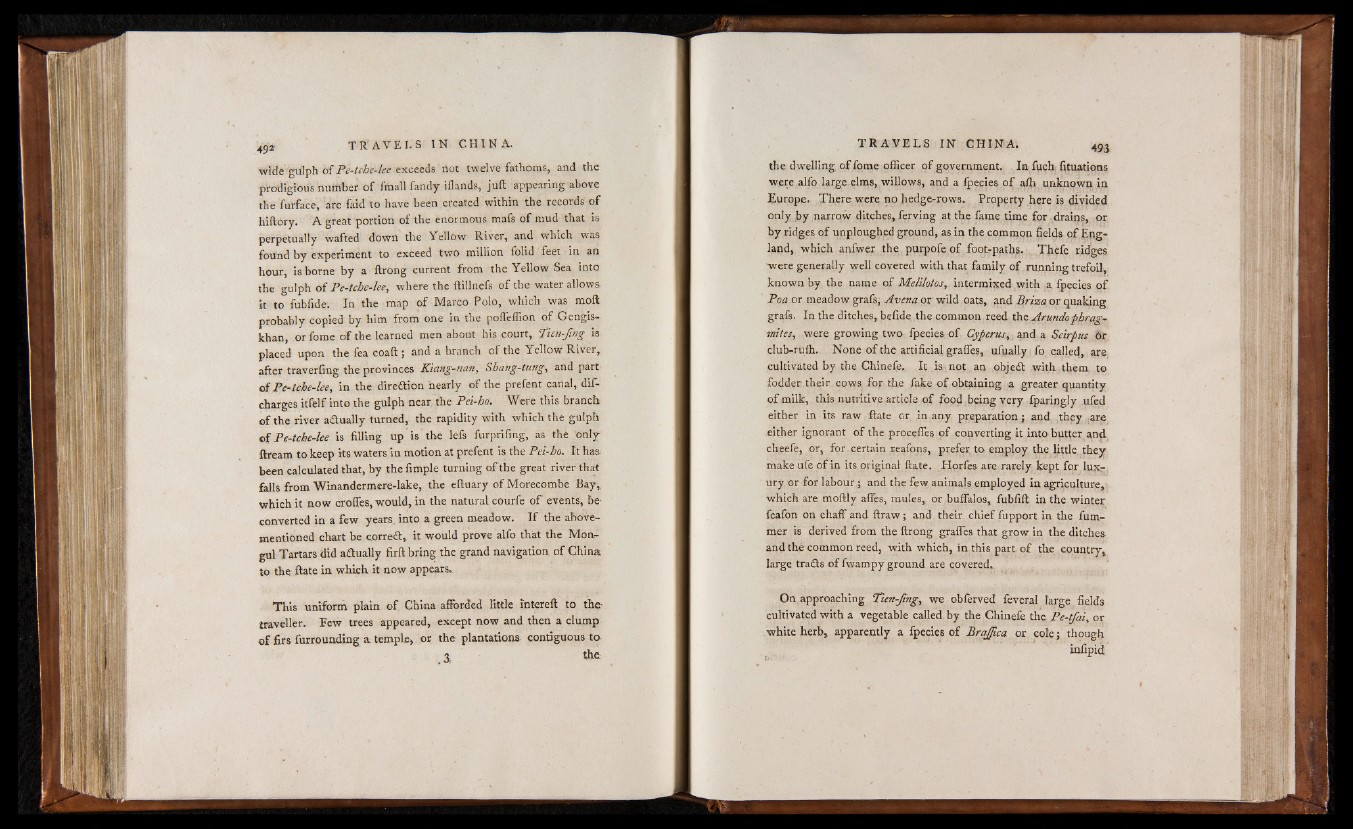
wide gulph o f Pe-tche-lee exceeds riot twelve fathoms, and the
prodigious number- o f fmall fandy iflands, juft appearing above
the furface, are faid to have been created within the records o f
hiftory. A great portion of the enormous mafs o f mud that is
perpetually wafted down the Yellow River, and which was
found by experiment to exceed two million folid feet in an
hour, is borne b y a ftrong current from the Yellow Sea into
the gulph o f Pe-tche-lee, where the ftillnefs o f the water allows
it to fubfide. In the map o f Marco Polo, which was moft
probably copied by him from one in the pofleffion o f Gengis-
khan, or fome o f the learned men about his court, Tien-Jing is
placed upon the fea coaft ; and a branch o f the Yellow River,
after traverling the provinces Kiang-?icin, Shang-tung, and part
o f Pe-tche-lee, in the diredion nearly o f the prefent canal, dif-
charges itfelf into the gulph near the Pei-ho. Were this branch
o f the river adually turned, the rapidity with which the gulph
o f Pe-tche-lee is filling up is the lefs furprifing, as the Only
ftream to keep its waters in motion at prefent is the Pei-ho. It has
been calculated that, by the fimple turning o f the great river that
f a l l s from Winandermere-lake, the eftuary o f Morecombe Bay,,
which it now crofles, would, in the natural courfe o f events, be-
converted in a few years, into a green meadow. I f the above-
mentioned chart be corred, it would prove alfo that the Mon-
gul Tartars did adually firft bring the grand navigation o f China
to the ftate in which it now appears.
This uniform plain o f China afforded tittle intereft to the-
traveller. Few trees appeared, except now and then a clump
o f firs furrounding a temple, or the plantations contiguous to
. 3, & e
the d welling o f fome officer o f government. In fuch fituatipns
were alfo large elms, willows, and a fpecies o f afh unknown in
Europe. There were no hedge-rows. Property here is divided
only jjy narrow ditches, ferving at the fame time for drains, or
by ridges o f unploughed ground, as in the common fields o f England,
which anfwer the purpofe o f foot-paths. Tfiefe ridges
•were generally well covered with that family o f running trefoil;
known by the name o f Melilotos, intermixed with a fpecies o f
Poa ormeadow grafs, Avena or wild oats, and Briza or quaking
grafs. In the ditches, befide the common reed the Arundophrag-
mites, were growing two fpecies o f Cyperus, and a Scirpus br
club-rufh. None o f the artificial grafles, ufually fo called, are
cultivated by the Chinefe. It is not an obje£t with, them to
fodder their cows for the fake o f obtaining a greater quantity
o f milk, this nutritive article o f food being very fparingly ufed
either in its raw ftate or in any preparation ; and they are
either ignorant o f the procefles o f converting it into butter and
cheefe, or, for certain reafons, prefer to employ the jittle they
make ufe o f in its original ftate. Horfes are rarely kept for lux-,
ury or for labour ; and the few animals employed in agriculture, ,
which are moftly affes, mules, or buffalos, fubfift in the winter
feafon on chaff and ftraw ; and their chief fupport in the fum-
mer is derived from the ftrong grafles that grow in the ditches
and thé common reed, with which, in this part, o f the country,
large traâs o f fwampy ground are covered.
On approaching Tten-Jîngy we obferved feveral large fields
cultivated with a vegetable called by the Chinefe the Pe-tjai, or
white herb, apparently a fpecies o f Brajfua or cole; though
infipid